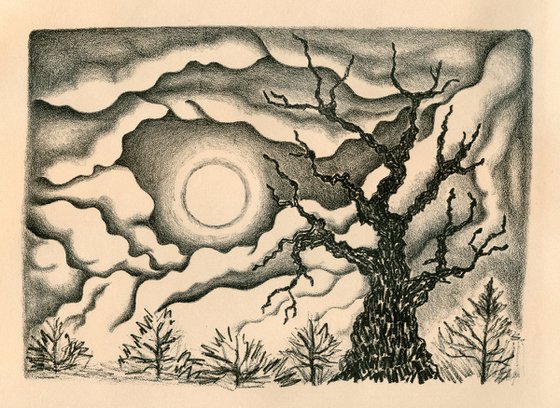- By medium
- By subject
- By budget
- Sales
- Gift cards
- Discover all art
- Artists
- Editors’ picks
- Ideas
Artwork description:
I am often awestruck by the site of the moon. Especially when I go outside, and a full moon is coming up close to the horizon, or when wispy clouds glide past it. Breathtaking!
This is a limited edition, printed with oil-based inks, from a limestone slab on archival Stonehenge paper. Each print is signed by me, numbered and is an original and unique piece of art.
A LITTLE BIT ABOUT THE PROCESS OF STONE LITHOGRAPHY
Lithography was invented in the late 18th century. It became a popular medium used by poster artists Chéret and Toulouse-Lautrec, and later by 20th century artists including Chagall, Matisse, and Picasso. The image is drawn on a porous surface, normally limestone, with a greasy litho crayon. Acid is applied, transferring the grease to the limestone, leaving the image ‘burned’ into the surface. A solution of gum arabic in water is applied, staying only on the surface not covered in grease-based residue of the drawing; oil-based ink is applied with a roller covering the entire surface; since water repels the oil in the ink, the ink adheres only to the greasy parts, perfectly inking the image. A sheet of damp paper is placed on the surface, and the image is transferred to the paper by the pressure of the printing press. Lithography is known for its ability to capture fine gradations in shading and very small detail.
Materials used:
archival Stonehenge paper, ink
Tags:
#moon #clouds #trees #moonlight #linocutMoon Gaze (2016) Lithograph
by Karen Barry
£108.48
- Lithograph on Paper
- From a limited edition of 20
- Size: 38.1 x 27.94cm (unframed) / 19.05 x 13.97cm (actual image size)
- Signed and numbered on the front
- Style: Graphic, illustrative and typographic
- Subject: Landscapes, sea and sky
Loading
Artwork description
I am often awestruck by the site of the moon. Especially when I go outside, and a full moon is coming up close to the horizon, or when wispy clouds glide past it. Breathtaking!
This is a limited edition, printed with oil-based inks, from a limestone slab on archival Stonehenge paper. Each print is signed by me, numbered and is an original and unique piece of art.
A LITTLE BIT ABOUT THE PROCESS OF STONE LITHOGRAPHY
Lithography was invented in the late 18th century. It became a popular medium used by poster artists Chéret and Toulouse-Lautrec, and later by 20th century artists including Chagall, Matisse, and Picasso. The image is drawn on a porous surface, normally limestone, with a greasy litho crayon. Acid is applied, transferring the grease to the limestone, leaving the image ‘burned’ into the surface. A solution of gum arabic in water is applied, staying only on the surface not covered in grease-based residue of the drawing; oil-based ink is applied with a roller covering the entire surface; since water repels the oil in the ink, the ink adheres only to the greasy parts, perfectly inking the image. A sheet of damp paper is placed on the surface, and the image is transferred to the paper by the pressure of the printing press. Lithography is known for its ability to capture fine gradations in shading and very small detail.
Materials used:
archival Stonehenge paper, ink
Tags:
#moon #clouds #trees #moonlight #linocut14 day money back guaranteeLearn more

